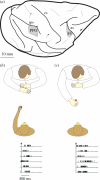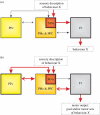From monkey mirror neurons to primate behaviours: possible 'direct' and 'indirect' pathways
- PMID: 19620103
- PMCID: PMC2865083
- DOI: 10.1098/rstb.2009.0062
From monkey mirror neurons to primate behaviours: possible 'direct' and 'indirect' pathways
Abstract
The discovery of mirror neurons (MNs), deemed to be at the basis of action understanding, could constitute the potential solution to the 'correspondence problem' between one's own and others' action that is crucial for of imitative behaviours. However, it is still to be clarified whether, and how, several imitative phenomena, differing in terms of complexity and cognitive effort, could be explained within a unified framework based on MNs. Here we propose that MNs could differently contribute to distinct imitative behaviours by means of two anatomo-functional pathways, subjected to changes during development. A 'direct mirror pathway', directly influencing the descending motor output, would be responsible for neonatal and automatic imitation. This proposal is corroborated by some new behavioural evidences provided here. During development, the increased control of voluntary movements and the capacity to efficiently suppress automatic motor activation during action observation assign to the core MNs regions essentially perceptuo-cognitive functions. These functions would be exploited by an 'indirect mirror pathway' from the core regions of the MN system to prefrontal cortex. This latter would play a key role in parsing, storing and organizing motor representations, allowing the emergence of more efficient and complex imitative behaviours such as response facilitation and true imitation.
Figures




Similar articles
-
Imitation: is cognitive neuroscience solving the correspondence problem?Trends Cogn Sci. 2005 Oct;9(10):489-95. doi: 10.1016/j.tics.2005.08.007. Trends Cogn Sci. 2005. PMID: 16126449 Review.
-
The mirror mechanism and mu rhythm in social development.Neurosci Lett. 2013 Apr 12;540:15-20. doi: 10.1016/j.neulet.2012.10.006. Epub 2012 Oct 11. Neurosci Lett. 2013. PMID: 23063953 Free PMC article. Review.
-
From monkey-like action recognition to human language: an evolutionary framework for neurolinguistics.Behav Brain Sci. 2005 Apr;28(2):105-24; discussion 125-67. doi: 10.1017/s0140525x05000038. Behav Brain Sci. 2005. PMID: 16201457
-
Action, observation or imitation of virtual hand movement affect differently regions of the mirror neuron system and the default mode network.Brain Imaging Behav. 2018 Oct;12(5):1363-1378. doi: 10.1007/s11682-017-9804-x. Brain Imaging Behav. 2018. PMID: 29243119
-
Functions of the mirror neuron system: implications for neurorehabilitation.Cogn Behav Neurol. 2006 Mar;19(1):55-63. doi: 10.1097/00146965-200603000-00007. Cogn Behav Neurol. 2006. PMID: 16633020 Review.
Cited by
-
Spontaneous emergence, imitation and spread of alternative foraging techniques among groups of vervet monkeys.PLoS One. 2012;7(10):e47008. doi: 10.1371/journal.pone.0047008. Epub 2012 Oct 10. PLoS One. 2012. PMID: 23071698 Free PMC article.
-
Human toddlers' attempts to match two simple behaviors provide no evidence for an inherited, dedicated imitation mechanism.PLoS One. 2012;7(12):e51326. doi: 10.1371/journal.pone.0051326. Epub 2012 Dec 10. PLoS One. 2012. PMID: 23251500 Free PMC article.
-
Contagious yawning in gelada baboons as a possible expression of empathy.Proc Natl Acad Sci U S A. 2009 Nov 17;106(46):19262-7. doi: 10.1073/pnas.0910891106. Epub 2009 Nov 4. Proc Natl Acad Sci U S A. 2009. PMID: 19889980 Free PMC article.
-
To imitate or not: Avoiding imitation involves preparatory inhibition of motor resonance.Neuroimage. 2014 May 1;91:228-36. doi: 10.1016/j.neuroimage.2014.01.027. Epub 2014 Jan 25. Neuroimage. 2014. PMID: 24473096 Free PMC article.
-
Action recognition depends on observer's level of action control and social personality traits.PLoS One. 2013 Nov 22;8(11):e81392. doi: 10.1371/journal.pone.0081392. eCollection 2013. PLoS One. 2013. PMID: 24303046 Free PMC article.
References
-
- Abravanel E., Sigafoos A. D.1984Exploring the presence of imitation during early infancy. Child Dev. 55, 381–392 (doi:10.2307/1129950) - DOI - PubMed
-
- Addessi E., Galloway A. T., Visalberghi E., Birch L. L.2005Specific social influences on the acceptance of novel foods in 2–5-year-old children. Appetite 45, 264–271 (doi:10.1016/j.appet.2005.07.007) - DOI - PubMed
-
- Anderson J. R., Myowa-Yamakoshi M., Matsuzawa T.2004Contagious yawning in chimpanzees. Proc. Biol. Sci. 271(Suppl. 6), S468–S470 (doi:10.1098/rsbl.2004.0224) - DOI - PMC - PubMed
-
- Armand J., Olivier E., Edgley S., Lemon R. N.1996The structure and function of the developing corticospinal tract: some key issue. In The neurophysiology and psychology of hand movements (eds Wing H. A., Haggard P., Flanagan J. R.), pp. 125–145 San Diego, CA: Academic Press
-
- Bauer J., Held R.1975Comparison of visually guided reaching in normal and deprived infant monkeys. J. Exp. Psychol. Anim. Behav. Process 1, 298–308 (doi:10.1037/0097-7403.1.4.298) - DOI - PubMed
Publication types
MeSH terms
Grants and funding
LinkOut - more resources
Full Text Sources

